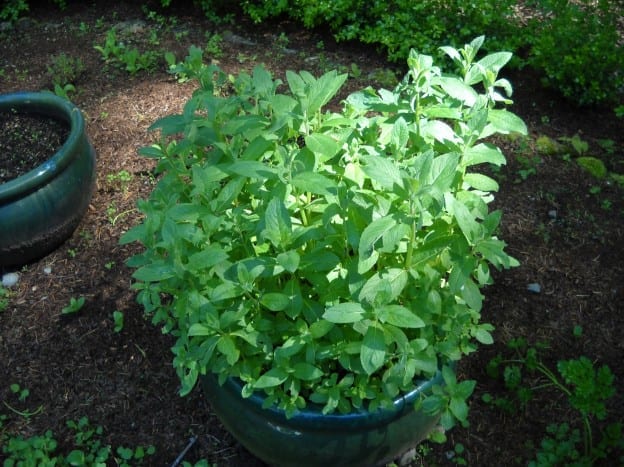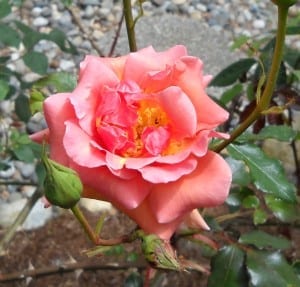 Three days to summer solstice and then slowly, or not, the wheel will turn towards harvest time and winter again.
Three days to summer solstice and then slowly, or not, the wheel will turn towards harvest time and winter again.
For now though we can enjoy the summer beauty and enticing scents of all the flora working hard to outshine the competition and attract the local pollinaters.
Jean’s garden is full of all kinds of life and it just feels wonderful to stroll through the pathways, enjoy the breeze and gratefully snip a bit of something here and there to add to the latest project. Thank you, thank you, thank you.
Back in March when we started these posts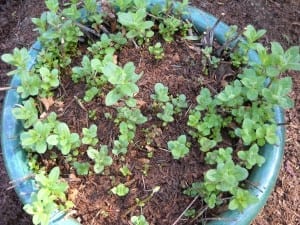 , this was my first picture of one of the many mint varieties growing in Jean’s garden.
, this was my first picture of one of the many mint varieties growing in Jean’s garden.
Growing mint in a pot is a good idea, as it tends to multiply. It also loves to explore, making extra work of the weeding variety for a gardener.
Any ducks you might have will be very happy however to eat any adventurous plants that get outside the pot.
Catnip is another member of the mint family and my experience is that plants tend be uprooted or to disappear entirely if left unprotected from local felines.
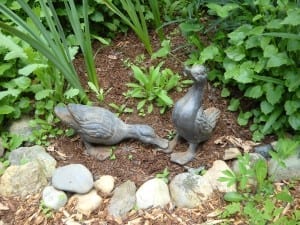 You may be familiar with common mint and spearmint but there are an amazing range of flavours available today, including, apple, chocolate, ginger, grapefruit, lemon and lime.
You may be familiar with common mint and spearmint but there are an amazing range of flavours available today, including, apple, chocolate, ginger, grapefruit, lemon and lime.
Peppermint is a natural insect repellent. You can put a couple of drops on a cotton ball and leave it where the critters are entering your home or try putting a few drops on a moist cloth and wiping down the places ants like to gather such as your kitchen and pantry cupboards. In the Middle Ages, cheesemakers would sprinkle mint leaves on the shelves where the cheeses were aging on help keep the rats away.
Propagation can be done by splitting clumps or from cuttings. In some areas caterpillars can be a problem and some varieties can be prone to rust but mint is an easy plant to grow.
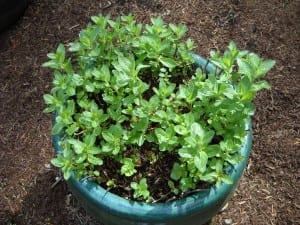 The picture to the right was taken early May. Mints like moist, rich soils and thrive in partial shade to full sun.
The picture to the right was taken early May. Mints like moist, rich soils and thrive in partial shade to full sun.
Find a location away from direct sunlight that is warm and airy for drying mint leaves. Once dried, they will store well in an airtight container.
When using mint in cooking, dried flakes are less assertive and will not overpower other flavours the way that fresh leaves can.Try mint with potatoes, peas, salads and the more traditional roast lamb.
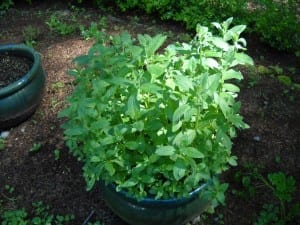 Mint leaves make an excellent digestive tea and is helpful in relieving some of the symptoms related to indigestion, gas, cramping and nausea.
Mint leaves make an excellent digestive tea and is helpful in relieving some of the symptoms related to indigestion, gas, cramping and nausea.
A friend of mine makes a simple syrup solution with fresh mint that sits in the back of his fridge and during the summer months he adds a little to many of his cold beverages.
This last picture was taken about ten days ago.
As with any herb, morning time is the best time to harvest your mint.The volatile oils are at their strongest at the beginning of the day.
Mint brings a masculine element into your workings and is connected to healing and purification.
For more information on spearmint click on this link http://www.herbs-info.com/spearmint.html
Please share your thoughts and uses of mint by clicking back one page and posting them in the comment field.
Bright Blessings!

